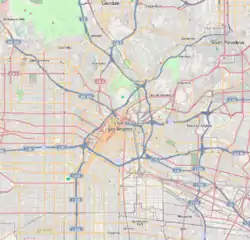Victor Heights | |
|---|---|
| Nickname: Forgotten Edge | |
 Victor Heights Location within Los Angeles | |
| Coordinates: 34°04′09″N 118°14′47″W / 34.069143°N 118.246456°W | |
| Country | |
| State | |
| County | |
| Time zone | Pacific |
| Zip Code | 90012 |
| Area code | Area code 213 |
Victor Heights, sometimes referred to as the Forgotten Edge,[1] is a neighborhood in Central Los Angeles.
History
The neighborhood was named after Victor Beaudry, a water mogul. He was the younger brother of Prudent Beaudry who was the 13th Mayor of Los Angeles, California from 1874 to 1876. [2] In 1887, Victor Heights was advertised as having "Choice lots, commanding a splendid view" for $1,200. Lesser lots went for $700 to $1,300. All had "Water piped through the street."[3] In 1908 its residents took a fight against disruptive dynamite blasting by the Los Angeles Brick Company in Chavez Ravine to the Los Angeles City Police Commission. They complained that the explosions were "cracking the plaster on their walls and causing their homes to settle to such an extent that they could not open their doors.[4]
Geography
.jpg.webp)
Victor Heights
Victor Heights is located northwest of Downtown Los Angeles. It is bounded by Sunset Boulevard on the south, 110 freeway and Chinatown on the east, Stadium Way on the north, and Marview Avenue on the west.[5][6]
It is a neighborhood of steep hills where new condominium complexes stand next to 1920s-era bungalow houses and old apartment buildings[1][7] The neighborhood backs up against Elysian Park.[2][1] In the 19th century, an oval-shaped parcel (where the former Metropolitan Water District headquarters stands) was Beaudry Park.[2]
Government
Victor Heights is part of the Historic Cultural North Neighborhood Council (HCNNC) which represents Chinatown, El Pueblo, Solano Canyon, and Victor Heights in the City of Los Angeles.[8]
Demographics
In 2009, The Los Angeles Times defined the neighborhood's demographic mix as older Italians and Croatians who once dominated the area, along with newer Asian and Latino immigrants, and a smattering of hipsters.[7]
Forgotten Edge
The neighborhood residents selected the nickname "Forgotten Edge" in 1992 when they formed a "neighborhood watch" group. Residents were frustrated about being transferred back and forth between the Central and Northeast police divisions whenever they tried to phone in a crime report because the Police Department couldn’t figure out where Figueroa Terrace and a pocket of neighboring streets were.[1]

Peacocks
A notable neighbor of Victor Heights are the peacocks and peahens that reside on the lawns and rooftops but adopted by the community as part of its urban landscape.[7]
Landmarks
.jpg.webp)
- The Eastside Market - Opened in 1929, the Eastside Market is the last remaining original Italian market in the area. Those markets serviced a predominately Italian immigrant community which adopted Victor Heights as an Italian enclave.[9][10] On February 14, 2017, the Los Angeles City Council designated the intersection of Alpine Street and Figueroa Terrace as “Eastside Market Square” and instructed the Department of Transportation to fabricate and install appropriate signage.[11]
- Metropolitan Water District Building - designed by William Pereira. The land was purchased in 1959 for $1.2 million, and construction was completed in 1963.[12]
- Everett Park, an L.A. municipal park sometimes called Teardrop Park due to its shape, noted for its excellent views of the downtown skyline, is located in the Forgotten Edge.[13]
External Links
- "Victor Heights Neighborhood Map". zipdatamaps.com. Retrieved 3 July 2023.
References
- 1 2 3 4 Yokoi, Iris (1994-03-27). "CHINATOWN/ECHO PARK: "Forgotten Edge" Takes a Stand". Los Angeles Times. p. 7. ProQuest 282279790.
- 1 2 3 Roger Vincent (March 6, 2014), Vacant offices designed by William Pereira to become apartments Los Angeles Times.
- ↑ Humanities, National Endowment for the (January 1, 1887). "Los Angeles daily herald. [microfilm reel] (Los Angeles [Calif.]) 1884-1890, January 01, 1887, Image 20" – via chroniclingamerica.loc.gov.
- ↑ ""No Half Measures on Blasting Asked," Los Angeles Herald, August 19, 1908, page 12".
- ↑ "Historic Cultural North Neighborhood Council Map" (PDF). Office of the City Clerk. Retrieved 31 March 2022.
- ↑ "Boundaries". hcnnc.org. Retrieved 31 March 2022.
- 1 2 3 DiMassa, Cara Mia (May 11, 2009). "Where peafowl don't run afoul". Los Angeles Times. Retrieved 30 March 2022.
- ↑ "HCNNC". hcnnc.org. Retrieved 31 March 2022.
- ↑ Brightwell, Eric (February 7, 2018). "No Enclave — Exploring the Remains of Los Angeles's Little Italy". California Fool’s Gold. Retrieved 2022-07-26.
- ↑ Brightwell, Eric (2015-02-07). "Exploring Victor Heights". California Fool’s Gold. Retrieved 2022-07-26.
- ↑ Cedillo, Gilbert (February 14, 2017). "Council File 17-0169" (PDF). City of Los Angeles. Retrieved 30 March 2022.
I THEREFORE MOVE that the City Council designate the intersection of Alpine Street and Figueroa Terrace as the "Eastside Market Square" and that the Department of Transportation be directed to fabricate and install appropriate ceremonial signs to this effect at this location. Presented by: Gilbert A. Cedillo Council member, 1st District
- ↑ "Los Angeles Department of City Planning RECOMMENDATION REPORT" (PDF). LACity.org. July 21, 2016. p. 16. Retrieved 31 March 2022.
In 1959 the MWD purchased a seven acre parcel of land at Sunset Boulevard and Beaudry Avenue in the Victor Heights neighborhood for $1.2 million.
- ↑ Angeleno, Militant (2009-05-12). "Militant Angeleno: WTF Week: The Militant Walks From Union Station To Elysian Park (2.1 mi)". Militant Angeleno. Retrieved 2022-08-15.